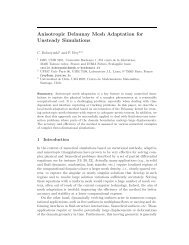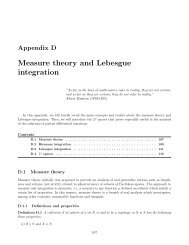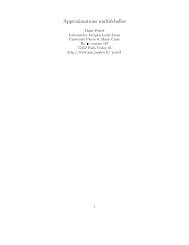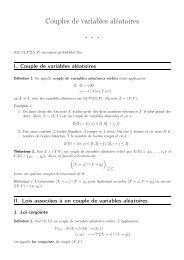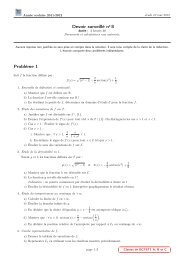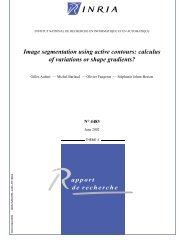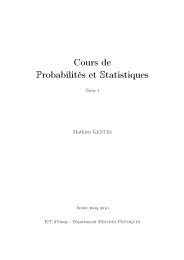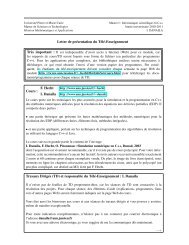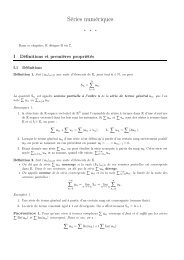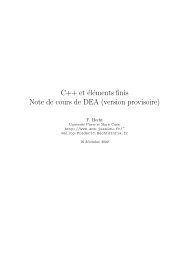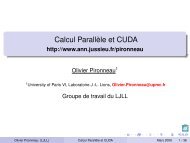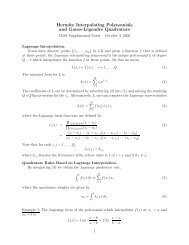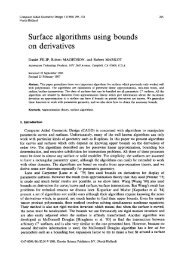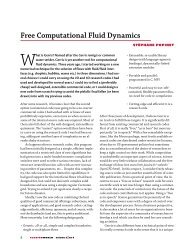pdf file
pdf file
pdf file
Create successful ePaper yourself
Turn your PDF publications into a flip-book with our unique Google optimized e-Paper software.
BOGOLIUBOV SPECTRUM OF INTERACTING BOSE GASES 5<br />
Acknowledgement. M.L. and P.T.N. acknowledge financial support from<br />
the European Research Council under the European Community’s Seventh<br />
Framework Programme(FP7/2007-2013 Grant Agreement MNIQS 258023).<br />
S.S.wassupportedbyaEURYIaward. J.P.S.wassupportedbyagrantfrom<br />
the Danish Council for Independent Research | Natural Sciences.<br />
2. Main abstract results<br />
In this section we state our main result.<br />
2.1. Assumptions. We start by giving the main assumptions on T and w,<br />
under which our results apply. Later in Section 3 we consider two specific<br />
examples, for which all the following assumptions are satisfied.<br />
Thefirstcondition concernsthepropertiesof T andwwhich arenecessary<br />
to give a proper meaning to the many-body Hamiltonian HN.<br />
(A1) (One- and two-body operators). The operator T : D(T) → L 2 (Ω) is<br />
a densely defined, bounded from below, self-adjoint operator. The function<br />
w : R d → R is Borel-measurable and w(x) = w(−x). Moreover, there exist<br />
constants C > 0, 1 > α1 > 0 and α2 > 0 such that<br />
−α1(Tx +Ty +C) ≤ w(x−y) ≤ α2(Tx +Ty +C) on L 2 (Ω 2 ). (5)<br />
Note that, although we keep the one-body operator T abstract, we use a<br />
two-bodyoperator w whichisatranslation-invariant multiplication operator<br />
in L 2 (Ω 2 ). This is only for convenience. All our results are also valid if<br />
w is an abstract two-body operator on H 2 which satisfies an estimate of<br />
the same type as (5), and if H = L 2 (Ω) is an abstract separable Hilbert<br />
space. However, in this case the expressions of the Hartree energy and of the<br />
corresponding nonlinear equations are different (they cannot be expressed<br />
using a convolution). We shall not consider this abstract setting to avoid<br />
any confusion.<br />
Under Assumption (A1), HN is bounded from below,<br />
HN ≥ (1−α1)<br />
N�<br />
Ti −CN. (6)<br />
i=1<br />
In the paper we always work with the Friedrichs extension [46], still denoted<br />
by HN. Note that we do not assume the positivity or boundedness of w<br />
or its Fourier transform, but only that it is relatively form-bounded with<br />
respect to T.<br />
Our second assumption is about Hartree theory.<br />
(A2) (Hartree theory). The variational problem (1) has a unique (up to a<br />
phase) minimizer u0 in the quadratic form domain Q(T) of T. Moreover,<br />
u0 is non-degenerate in the sense that<br />
� �<br />
h+K1 K2<br />
≥ ηH on H+ ⊕H+ (7)<br />
K ∗ 2 h+K1<br />
for some constant ηH > 0, where H+ = {u0} ⊥ . Here<br />
h := T +|u0| 2 ∗w −µH,



